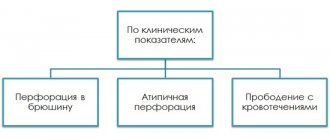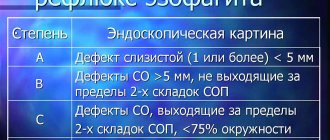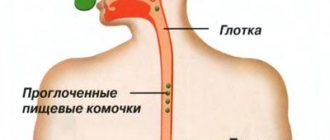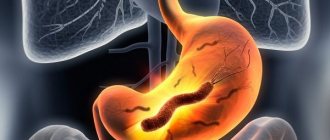Causes of stomach ulcers
Most often, peptic ulcer disease is associated with an imbalance between aggressive and protective factors affecting the mucous membrane of the stomach or duodenum. Aggressive factors include hydrochloric acid, which is part of the gastric juice, liver bile acids, which enter the duodenum, as well as the reflux of the contents of the duodenum into the stomach. Protective factors are mucus secreted by the gastric mucosa, normal blood circulation, timely restoration and renewal of mucosal cells.
Clinical picture of peptic ulcer
The two leading syndromes for gastric and duodenal ulcers are pain and dyspepsia. Pain usually occurs in the upper abdomen (under the stomach) and in the umbilical region. Pain appears on an empty stomach and a couple of hours after eating.
Dyspeptic syndrome is manifested by heartburn and belching, sour or bitter taste in the mouth, nausea and vomiting, and flatulence. Often duodenal ulcers manifest as constipation or diarrhea.
In addition to typical complaints, patients may present with lethargy and sweating, fatigue and decreased appetite. If the disease lasts for a long time, patients note weight loss, which is associated with the fear of eating something that will cause pain. In addition, patients with peptic ulcers are emotionally unstable.
The disease is characterized by seasonality of exacerbations (autumn-spring). An asymptomatic course of peptic ulcer disease is also possible, which often leads to serious complications:
- bleeding;
- perforation of the ulcer (requires immediate surgery);
- development of cancer of the affected organ
- cicatricial stenosis.
Symptoms of a stomach ulcer
The most common complaint characterizing the presence of a peptic ulcer in a patient is pain in the stomach.
Abdominal pain
The pain of a stomach ulcer is in most cases sharp, burning, aching. However, the pain can also be vague, dull or felt like a feeling of fullness in the stomach (heaviness in the abdomen), sometimes reminiscent of hunger. In people suffering from duodenal ulcers, abdominal pain occurs 1.5-3 hours after eating. Night attacks of pain often occur.
Differential diagnosis
Differential diagnosis is carried out with exacerbation of chronic gastritis, hiatal hernia, exacerbation of chronic cholecystitis, pancreatitis, stomach cancer, pancreatic cancer, symptomatic ulcers.
- In chronic HP-associated gastritis, the pain syndrome is ulcer-like in nature; in autoimmune gastritis, heaviness in the epigastrium, belching, nausea, and heartburn are noted. Definitive diagnosis is made by endoscopy.
- A hiatal hernia is accompanied by pain in the epigastrium, but unlike a peptic ulcer, the pain syndrome is associated with the position of the body: the pain intensifies after eating in a lying position. X-ray examination confirms the diagnosis.
- In chronic cholecystitis, pain is localized in the right hypochondrium, often radiating to the right scapula and shoulder. There may be nausea, constipation, flatulence. On palpation, pain is noted in the right hypochondrium, at the point of the gallbladder, a positive phrenicus symptom. The diagnosis is confirmed by ultrasound examination of the abdominal cavity and endoscopic retrograde cholepancreatography.
- With exacerbation of chronic pancreatitis, pain is localized in the left hypochondrium, often of a girdling nature. The diagnosis is confirmed by the results of a biochemical blood test for pancreatic enzymes, stool digestibility, ultrasound and computed tomography.
- Gastric cancer is characterized by middle and older age of the patient. At the beginning of the disease, the pain is often dull, and the connection with eating is lost. In addition, there may be complaints of decreased and perverted appetite, nausea, vomiting, and general weakness. The diagnosis is confirmed by endoscopy with biopsy.
Methods for diagnosing stomach ulcers
In the diagnosis of gastric ulcers, instrumental diagnostics and laboratory methods are used. The main importance is attached to the endoscopic method - EGDS (gastroscopy).
Gastroscopy
Gastroscopy allows you to identify ulceration, clarify its location, size and depth, and determine whether bleeding is occurring. Gastroscopy also makes it possible to evaluate the relief and elasticity of the mucosa.
More information about the diagnostic method
X-ray
For stomach ulcers, a diagnostic method such as fluoroscopy can be used. Fluoroscopy is a real-time X-ray examination. The patient's stomach is filled with a contrast agent. Using X-rays, an image of the contours of the stomach is obtained. You can evaluate the dynamics of the passage of the contrast agent. In case of a gastric ulcer, examination reveals “niches” - a persistent accumulation of contrast agent on the relief of the mucous membrane or on the contour of the organ wall.
General blood analysis
With a peptic ulcer, you should expect that a general blood test will show an increase in the number of red blood cells, an increase in hemoglobin and a slowdown in ESR.
More information about the diagnostic method
Fecal occult blood test
The standard of examination for suspected gastric ulcers usually includes a stool occult blood test.
Detection of Helicobacter pylori
The cause of the inflammatory process in the stomach may be the bacterium Helicobacter pylori. In order for the treatment to be effective, it is necessary to establish its presence in the patient’s stomach. For this purpose the following may be carried out:
- taking a biopsy of the gastric mucosa during endoscopy for subsequent microscopic or cultural examination;
- urease breath test;
- stool analysis for detection of Helicobacter pylori antigen;
- serological blood test;
- PCR diagnostics.
Sign up for diagnostics To accurately diagnose the disease, make an appointment with specialists from the Family Doctor network.
Diagnosis of ulcers by blood
Many commercial laboratories offer diagnosis of Helicobacter pylori infection using a blood test. The essence of the technique is to determine the level of IgG class antibodies produced by the immune system in response to components of the cell membrane of the pathogen.
Such tests are even less sensitive and specific than a breath test because:
- Helicobacter is a widespread microorganism;
- this bacterium is responsible for the development of not only ulcers, but also chronic gastritis;
- Many people have asymptomatic H. pylori infection;
- positive test results do not allow us to unequivocally state the presence of peptic ulcer in a particular patient.
Treatment methods for stomach ulcers
The course of treatment for peptic ulcer disease is selected strictly individually and includes a whole range of drugs aimed at combating Helicobacter pylori, reducing the secretion and acidity of gastric juice.
As soon as a person suspects an ulcer, he should immediately seek advice from a gastroenterologist. You can contact any of the clinics of JSC “Family Doctor”. Our doctors will prescribe the necessary examinations and treat gastric and duodenal ulcers in accordance with the latest international standards.
Make an appointment Do not self-medicate. Contact our specialists who will correctly diagnose and prescribe treatment.
Rate how useful the material was
thank you for rating
Causes and mechanism of development of gastric and duodenal ulcers
To date, it has been proven that one of the causes of peptic ulcer disease is the opportunistic microorganism Helicobacter pylori. This statement is confirmed by the fact that in patients with gastric ulcers these bacteria are found in 80% of cases, and in people with duodenal ulcers in 90%. Peptic ulcer disease, like most other pathologies of the gastrointestinal tract, is a multifactorial disease. But there are also a number of predisposing factors for the development of peptic ulcers:
- genetic predisposition;
- poor nutrition (constant intake of spicy, coarse, sour and salty foods, snacks on the run, rare meals, addiction to fast food);
- excessive alcohol consumption;
- constant stress, or one-time, but strong;
- smoking;
- long-term use of certain medications (glucocorticoids, anti-inflammatory drugs);
- excessive physical work.
Prevention of exacerbations
Our experts recommend following some rules that prevent relapses of the disease:
- compliance with the diet and diet (spicy and salty foods, sour and rough foods are excluded, and the intake is fractional, up to 6 times a day);
- prohibition of smoking and drinking alcohol;
- elimination of physical and mental overload.
All patients with gastric and duodenal ulcers are subject to clinical observation. Gastroenterologists at the Yauza Clinical Hospital will select courses of anti-relapse treatment on an individual basis (they take place twice a year). In some cases, patients are prescribed ongoing maintenance therapy.
Treatment of peptic ulcers in our hospital is carried out in comfortable conditions, efficiently and effectively, thanks to highly qualified specialists, modern equipment and an individual approach to the treatment of each patient.
Treatment
The discovery of the role of Helicobacter pylori in the occurrence of ulcers has significantly facilitated the approach to treating this disease. Now peptic ulcer disease is not perceived as a life sentence.
Special three- and four-component treatment regimens have been developed with the help of which you can permanently get rid of the cause of peptic ulcer disease - the bacterium Helicobacter pylori, and therefore completely recover from the ulcer, avoiding subsequent exacerbations.
Mandatory components of all treatment regimens are antibiotics (two at a time), which are usually taken for 7-10 days. In addition, patients are prescribed drugs that neutralize the main component of gastric juice - hydrochloric acid (for example, omeprazole, pantoprazole, ranitidine, etc.), as well as drugs that form a protective film on the surface of the gastric mucosa (for example, de-nol).
All ulcer sufferers must follow the correct daily routine, adhere to a special diet, and, if possible, not be nervous. It is advisable to quit smoking and alcoholic beverages during treatment.
The active course of treatment takes on average 2 weeks, after which it is necessary to continue maintenance treatment and follow a diet. To monitor the healing of the ulcer, a repeat esophagogastroduodenoscopy is prescribed.
Surgical intervention is required extremely rarely - only for long-term non-healing stomach ulcers, as well as for complications of peptic ulcer disease. During surgery for peptic ulcers, the affected area of the stomach or intestine is most often removed, and some nerve branches are also cut, which helps reduce the acidity of gastric juice.
Symptoms
| Occurrence (how often a symptom occurs in a given disease) | |
| Bloating (flatulence, swelling, tympany, increased gas formation) | 90% |
| Acute pain in the epigastric region and a feeling of fullness and burning in the stomach | 90% |
| Heartburn | 80% |
| Nausea | 80% |
| Constipation | 70% |
| Frequent loose stools (diarrhea, diarrhea) | 70% |
| Reducing heartburn after drinking milk | 60% |
| Vomiting of various types, including indomitable | 50% |
| Deterioration in well-being after eating fatty, fried foods, chocolate, alcohol, carbonated drinks, or working at an incline | 0% |











